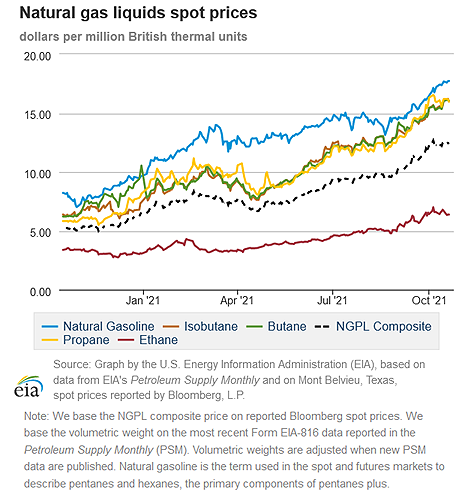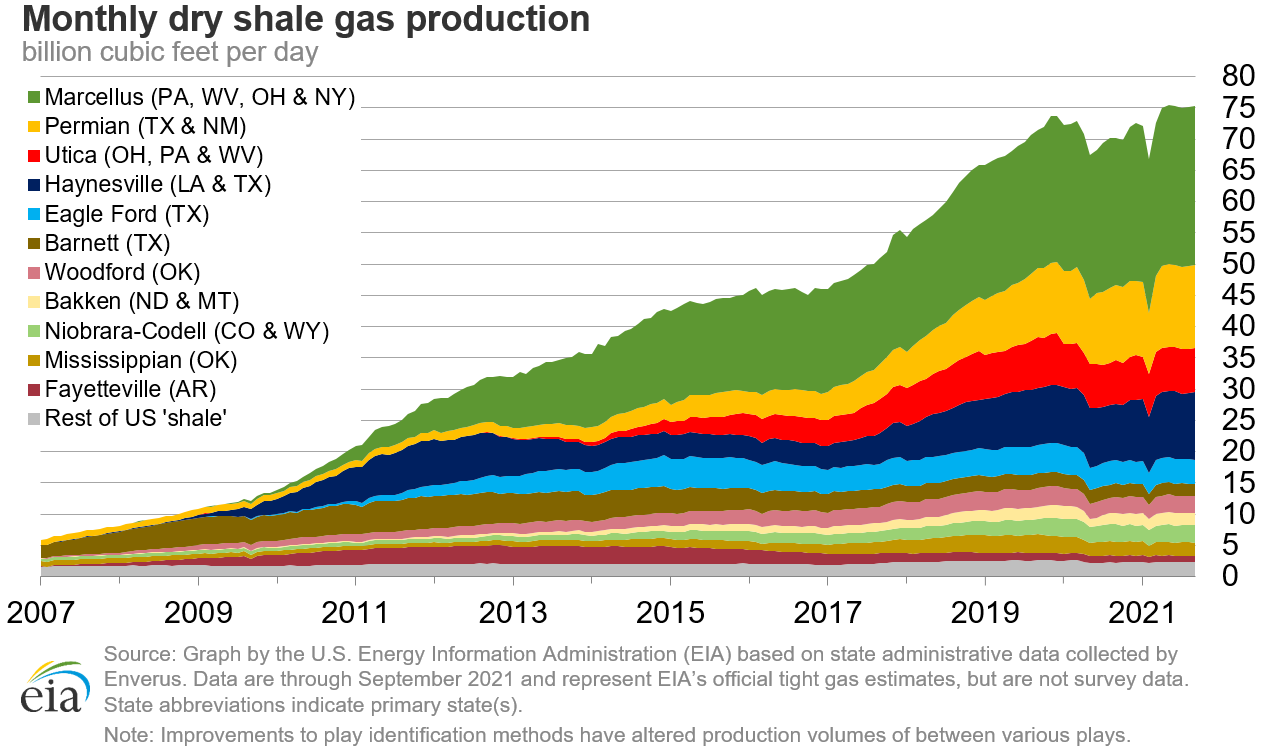In the News:
Growth in natural gas demand in Asia and low storage stocks in Europe lead to record-high spot prices
International spot natural gas and liquefied natural gas (LNG) prices in Europe and Asia have been setting record highs this year reaching $35 per million British thermal units (MMBtu) in Asia and nearly $40/MMBtu in Europe in the first week of October, according to pricing data by Bloomberg Finance, L.P. These prices are more than a twenty-fold increase from record lows during the summer 2020, when response measures to the COVID-19 pandemic significantly reduced global energy consumption.
Historically, spot natural gas prices in Europe have traded below spot LNG prices in Asia. This year, however, European spot and forward prices have been closely tracking LNG prices in Asia to attract higher volumes of flexible LNG supplies to Europe to refill storage inventories.
Several factors have contributed to significantly higher global spot natural gas and LNG prices this year, including:
- Growth in natural gas demand in Asia and Latin America
- Seasonally low natural gas storage inventories in Europe
- Reduced global LNG supply because of planned and unplanned outages at LNG export facilities in several countries
Significant growth in natural gas demand in Asia, led by China, contributed to increased demand for global spot LNG supplies in addition to volumes supplied under long-term contracts. In North Asia, a colder-than-normal winter and a hot summer led to higher natural gas demand and lower inventories. In addition, a shortage of coal supplies in China, higher LNG demand by the power and industrial sectors in Japan, and lower output by nuclear power plants in South Korea contributed to a significant increase in LNG imports. Last year, these countries—the world’s three largest LNG importers—accounted for 72% of total LNG imports in Asia and 52% of global LNG imports, according to the International Group of Liquefied Natural Gas Importers (GIIGNL).
Year-on-year, from January through August 2021:
- LNG imports to China, Japan, and South Korea have increased by a combined 3.7 billion cubic feet per day (Bcf/d) (16%), accounting for 95% of the increase in Asia’s total LNG imports.
- China’s LNG imports increased by 2.0 Bcf/d (24%) and averaged 10.4 Bcf/d, making China the world’s largest LNG importer during this period, surpassing Japan.
- LNG imports grew in Japan by 0.6 Bcf/d (7%) and in South Korea by 1.1 Bcf/d (21%).
Low natural gas storage inventories in Europe contributed to Europe’s natural gas spot price increasing to an all-time high in October 2021. As of October 18, 2021, natural gas inventories in Europe were 77% full, compared with 95% last year at this time and the 91% five-year (2016-2020) average, according to data from Gas Infrastructure Europe’s (GIE) Aggregated Gas Storage Inventory (AGSI+).
LNG demand growth in Brazil in response to its worst drought in more than 90 years contributed to increased use of natural gas for electricity generation and required higher LNG imports to offset lower hydroelectric output. In the first nine months of this year, Brazil’s LNG imports averaged 0.8 Bcf/d, compared with 0.1 Bcf/d on average during the same period in 2020, according to Brazil Ministry of Economy’s foreign trade statistics (Comex Stat).
Unplanned outages at LNG export plants in several countries also contributed to reduced supply of LNG to the global market, particularly in the summer months of this year. The outages included extended planned maintenance at several LNG export projects in Australia, Russia, and Papua New Guinea; unplanned outages related to technical issues at LNG production plants in Norway, Malaysia, and Peru; and lower feedstock natural gas supply available for LNG export plants in Nigeria, Angola, Egypt, and Trinidad and Tobago.
Overview:
(For the week ending Wednesday, October 20, 2021)
- Natural gas spot prices fell at most locations this report week (Wednesday, October 13 to Wednesday, October 20). The Henry Hub spot price fell from $5.45 per million British thermal units (MMBtu) last Wednesday to $4.79/MMBtu yesterday.
- International natural gas prices rose this report week. Bloomberg Finance, L.P. reports that swap prices for November liquefied natural gas (LNG) cargos in East Asia rose for the eighth week in a row to a weekly average of $33.92/MMBtu this report week, the highest weekly average on record since January (the first month for which comparable data are available) and 68 cents/MMBtu above last week’s average of $33.24/MMBtu. At the Title Transfer Facility (TTF) in the Netherlands, the most liquid natural gas spot market in Europe, day-ahead prices rose this report week to a weekly average of $30.43/MMBtu, up $1.03/MMBtu from last week’s average of $29.40/MMBtu. In the same week last year (week ending October 21, 2020), prices in East Asia and at TTF were $5.72/MMBtu and $5.08/MMBtu, respectively.
- The price of the November 2021 NYMEX contract decreased 42 cents, from $5.590/MMBtu last Wednesday to $5.170/MMBtu yesterday. The price of the 12-month strip averaging November 2021 through October 2022 futures contracts declined 19 cents to $4.530/MMBtu. The shape of the 12-month strip flattened this week compared to last week as a result of larger price declines in futures contracts for delivery during the current winter months and smaller price declines in futures contracts for delivery during the summer. The average futures strip for this winter’s remaining months (November 2021 through March 2022) declined by more than 31 cents, from an average of $5.675/MMBtu last Wednesday to $5.364/MMBtu yesterday. The futures strip for summer 2022 delivery months (April through September) remained relatively flat, declining 11 cents from $4.040/MMBtu last Wednesday to $3.930/MMBtu yesterday.
- The net injections to working gas totaled 92 billion cubic feet (Bcf) for the week ending October 15. Working natural gas stocks totaled 3,461 Bcf, which is 12% lower than the year-ago level and 4% lower than the five-year (2016–2020) average for this week.
- The natural gas plant liquids (NGPL) composite price at Mont Belvieu, Texas, rose by 20 cents/MMBtu, averaging $12.47/MMBtu for the week ending October 20. The ethane price fell 1%, which is less than the 5% decrease in the natural gas price at the Houston Ship Channel for the same period. The ethane premium over natural gas increased by 15%, or 19 cents/MMBtu, over the past week. Ethylene prices rose on average 4% this report week, expanding the margin between ethane and ethylene. Natural gasoline prices rose 2%, compared with the 1% increase in Brent crude oil prices. Prices of both butanes, normal butane and isobutane, rose 4% this report week as a result of rising demand for butane blending into winter-blend motor gasoline, which can accommodate higher shares of butane than low-Reid vapor pressure (RVP) summer-blend gasoline. Propane prices rose only 1%, less than the price rises of other heavy NGPLs, reflecting a relatively mild start to the winter heating season and reduced demand due to warmer-than-normal temperatures across much of the country. The propane premium to crude oil remained relatively flat this report week, rising by 1%.
- According to Baker Hughes, for the week ending Tuesday, October 12, the natural gas rig count decreased by 1 to 98 as a result of one-rig losses in the Utica play in Ohio, the Haynesville in Louisiana, and the Arkoma-Woodford in Oklahoma, offset by 1-rig gains in West Virginia and Mississippi. The number of oil-directed rigs rose by 12 to 445. The oil-rig count has increased for the sixth week in a row, and is now 51 rigs above the 394-rig total reported for the first week of September. The increase was broadly distributed across the country, with gains reported in Alaska (1), California (2), Louisiana (2), Texas (2), and Oklahoma (1). The total rig count increased by 10, and it now stands at 543, the highest level since mid-April of last year.
Prices/Supply/Demand:
Gulf Coast prices decline week over week as demand declines more than supply. This report week (Wednesday, October 13 to Wednesday, October 20), the Henry Hub spot price fell 66 cents from $5.45/MMBtu last Wednesday to $4.79/MMBtu yesterday. Prices reached a weekly high of $5.83/MMBtu on Friday before gradually tapering off to yesterday’s weekly low. IHS Markit estimates average weekly supply into Southern Louisiana, where the Henry Hub is located, fell by approximately 220 million cubic feet per day (MMcf/d) this report week as a result of lower receipts from the north and lower offshore production. After a two-day outage, Enbridge reports flows on the Mississippi Canyon Gas Pipeline (MCGP) from Shell’s offshore Olympus Platform returned to normal levels on October 15. MCGP carries more than 100 MMcf/d of liquids-rich natural gas from the Olympus platform for processing at Targa Resources’ 750 MMcf/d Venice natural gas processing plant near Venice, Louisiana. Flows on MCGP fell to zero on August 28 in advance of Hurricane Ida’s landfall. On October 2, natural gas flows from Shell’s Olympus platform resumed; however, Shell’s West Delta-143 (WD-143) platform, through which production from the Shell-operated Mars and Ursa platforms flows, remains offline due to damage sustained during Hurricane Ida. These shut-ins have resulted in continuing impairment of natural gas production at these facilities, which averaged approximately 220 MMcf/d before the shut-in.
Demand in the region fell by more than supply as a result of lower power generation demand and lower outflows of natural gas to other regions. LNG feed gas to terminals in Southern Louisiana also declined this report week, despite the gradual start-up of Venture Global’s Calcasieu Pass LNG terminal. On October 18, Venture Global received approval from the Federal Energy Regulatory Commission (FERC) to begin introducing natural gas to its hot oil heaters and the warm flare at the export terminal, which is located on the coast of the Gulf of Mexico just south of Lake Charles, Louisiana. The TransCameron pipeline, which delivers natural gas to the terminal, reported increased flows to the terminal on October 20, which are currently averaging approximately 12 MMcf/d.
Midwest prices decline this week amid mild temperatures. At the Chicago Citygate, the price decreased 35 cents from $5.18/MMBtu last Wednesday to $4.83/MMBtu yesterday as a result of a warming trend across the central Lower 48 states, which reduced heating demand across the region. Temperatures in Chicago this week averaged in the high 50s and low 60s, resulting in 0 cooling degree days (CDD—a measure of air conditioning demand) and lower-than-normal heating degree days (HDD—a measure of heating demand). The Chicago area had 44 HDDs this week, compared with 82 HDDs under a normal weather scenario for this time of year.
Prices in California are mixed this report week, falling in the north and rising in the south. The price at PG&E Citygate in Northern California fell 10 cents, from $6.86/MMBtu last Wednesday to $6.76/MMBtu yesterday. The price at Sumas on the Canada-Washington border, one of the few pricing points in North America where prices rose last week, fell $1.47 from $6.55/MMBtu last Wednesday to $5.08/MMBtu yesterday, which resulted in lower prices at Malin, Oregon, the northern delivery point into PG&E service territory. The price at Malin, Oregon, fell 57 cents from $5.58/MMBtu last Wednesday to $5.01/MMBtu yesterday. Prices at the PG&E Citygate and at Malin reached weekly highs on Thursday, at $7.13/MMBtu and $5.66/MMBtu, respectively.
The price at SoCal Citygate in Southern California increased 2 cents from $6.00/MMBtu last Wednesday to $6.02/MMBtu yesterday after reaching a weekly high of $6.92/MMBtu on Monday. The capacity to transport natural gas into Southern California remains impaired. Pipeline remediation on Line 1300 of the El Paso Natural Gas (EPNG) pipeline, which began on Tuesday, has reduced natural gas flows on the EPNG system by approximately 330 MMcf/d, reducing capacity to ship natural gas into the Desert Southwest and Southern California from the Permian production region in West Texas this week. The maintenance, which is scheduled to end on October 26, is in addition to the continuing outage on Line 2000, which has reduced flows into Southern California on the line to zero, compared with approximately 610 MMcf/d before the pipeline ruptured near Coolidge, Arizona, on August 15. Price increases in SoCal Gas territory were relatively muted because, under current weather conditions, demand for natural gas in the region remains subdued. Sempra Energy, owner of SoCalGas, reports a balanced natural gas market with a potential for excess supply developing further into the week as a result of reduced ability to store natural gas in its territory. SoCalGas reports the Aliso Canyon natural gas storage field reached maximum capacity on October 14 and is not available for further injections. Combined with planned maintenance at the Honor Rancho natural gas storage field, which began on October 15 and is scheduled to end at midnight on October 30, the ability of SoCalGas to balance its system through storage has been reduced by close to 750 MMcf/d.
Northeast prices decline as warmer-than-normal temperatures limit the need for heating. At the Algonquin Citygate, which serves Boston-area consumers, the price went down 78 cents from $5.30/MMBtu last Wednesday to $4.52/MMBtu yesterday. Temperatures in the Boston Area averaged 62°F this week, resulting in 28 HDDs and 7 CDDs compared with 75 HDDs and 0 CDDs under a normal weather scenario for this time of year in the Boston area. At the Transcontinental Pipeline (Transco) Zone 6 trading point for New York City, the price decreased 70 cents from $4.85/MMBtu last Wednesday to $4.15/MMBtu yesterday. Prices at Transco Zone 6 reached weekly highs on Thursday of $5.24/MMBtu, a day ahead of the highest temperatures of the month. In New York’s Central Park, Friday temperatures reached a daily high of 79°F, 14°F above normal, resulting in 6 CDDs. IHS Markit estimates natural gas consumption for power generation in the New York/New Jersey region reached close to 2 Bcf/d on Friday, the highest daily average since the fourth week of September. IHS Markit estimates feed gas to the Cove Point LNG export terminal in Maryland averaged approximately 750 MMcf/d this report week, more than 500 MMcf/d higher than last week, reflecting a full week of operations after maintenance at the facility was completed on Tuesday, October 12 (notice ID 124956).
Prices in the Appalachian Basin production region fall, reflecting similar declines in the Northeast. The Tennessee (TGP) Zone 4 Marcellus spot price decreased 46 cents from $4.67/MMBtu last Wednesday to $4.21/MMBtu yesterday. The price at Eastern Gas South in southwest Pennsylvania fell 64 cents from $4.76/MMBtu last Wednesday to $4.12/MMBtu yesterday. Both hubs reached weekly highs on Thursday, which is consistent with weekly highs reported in the Northeast; TGP Zone 4 Marcellus rose to $4.90/MMBtu and Eastern Gas South to $5.02/MMBtu. Planned maintenance on the NEXUS Gas Transmission pipeline continued this week and is expected to conclude by the end of October.
Prices in the Permian Basin decline this week as natural gas flows and production decline. The price at the Waha Hub in West Texas, which is located near Permian Basin production activities, fell 14 cents this report week, from $4.72/MMBtu last Wednesday to $4.58/MMBtu yesterday. The Waha Hub traded 21 cents below the Henry Hub price yesterday, compared with last Wednesday, when it traded 73 cents below the Henry Hub price. Waha prices decreased by a smaller amount than Henry Hub prices as a result of decreased production. Production in the Permian Basin fell this week in response to impaired westbound pipeline capacity out of the Permian Basin (see SoCal section above). IHS Markit reports that net outflows from the Permian Basin and natural gas production in the basin both decreased by 0.2 Bcf/d this report week.
U.S. supply of natural gas rises slightly this report week as a result of an increase in net imports from Canada. According to data from IHS Markit, the average total supply of natural gas rose by 0.3% compared with the previous report week from an average of 97.8 Bcf/d last report week to 98.1 Bcf/d this report week. Dry natural gas production declined by 0.6% (0.5 Bcf/d), but the decline was offset by an increase in net imports from Canada of 15.5% (0.8 Bcf/d).
U.S. natural gas consumption increases week over week, led primarily by an increase in the residential/commercial sector. Total U.S. natural gas demand rose by 1.9% (1.6 Bcf/d) compared with the previous report week, according to data from IHS Markit. Natural gas consumed for power generation declined by 10.4% (3.2 Bcf/d), but the decline was more than offset by week-over-week increases in other sectors. Average weekly residential and commercial sector consumption increased 36.9% (3.8 Bcf/d) to 14.0 Bcf/d as the country transitions into the winter heating season. Nonetheless, the National Oceanic and Atmospheric Administration (NOAA) reports temperatures across most of the Midwest and Northeast at above-normal levels for this time of year, resulting in lower levels of residential and commercial sector consumption than for the same week last year, when the sector consumed 14.4 Bcf/d, according to IHS Markit estimates. Consumption in the industrial sector increased 2.2% (0.5 Bcf/d). Exports also rose. Pipeline exports to Mexico rose by 4.2% (0.2 Bcf/d) to 5.9 Bcf/d, and deliveries of feed gas to LNG export terminals rose by 3.5% (0.4 Bcf/d) to 10.9 Bcf/d, reflecting higher feed gas consumption in the Northeast that more than offset lower feed gas consumption in Louisiana.
U.S. LNG exports increase week over week. Twenty LNG vessels (eight from Sabine Pass and four each from Cameron, Corpus Christi, and Freeport) with a combined LNG-carrying capacity of 74 Bcf departed the United States between October 14 and October 20, 2021, according to shipping data provided by Bloomberg Finance, L.P.
Storage:
The net injections into storage totaled 92 Bcf for the week ending October 15, compared with the five-year (2016–2020) average net injections of 69 Bcf and last year's net injections of 49 Bcf during the same week. Working natural gas stocks totaled 3,461 Bcf, which is 151 Bcf lower than the five-year average and 458 Bcf lower than last year at this time.
According to The Desk survey of natural gas analysts, estimates of the weekly net change to working natural gas stocks ranged from net injections of 79 Bcf to 96 Bcf, with a median estimate of 90 Bcf.
The average rate of injections into storage is 7% lower than the five-year average so far in the refill season (April through October). If the rate of injections into storage matched the five-year average of 6.7 Bcf/d for the remainder of the refill season, the total inventory would be 3,568 Bcf on October 31, which is 151 Bcf lower than the five-year average of 3,719 Bcf for that time of year.
More storage data and analysis can be found on the Natural Gas Storage Dashboard and the Weekly Natural Gas Storage Report.
See also:
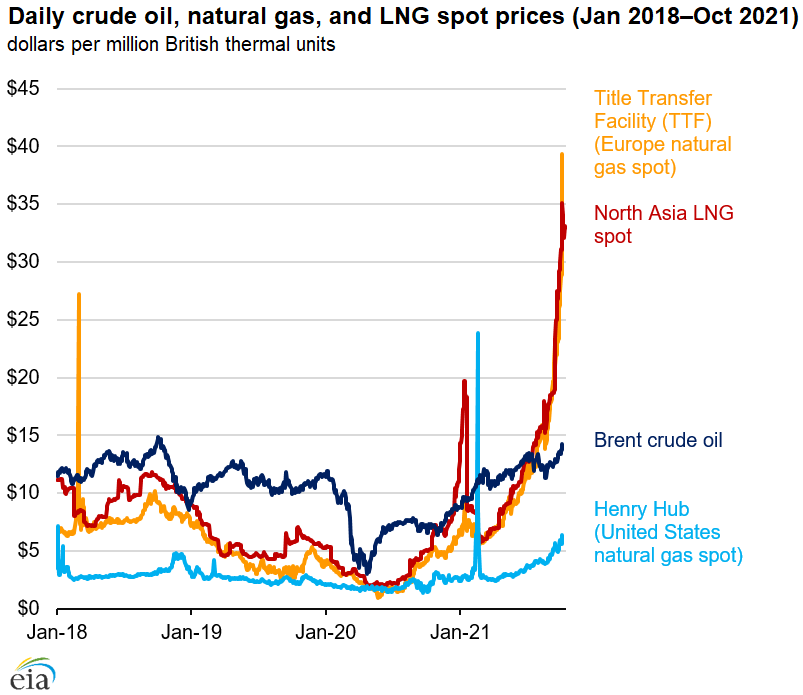 Source: Graph created by the U.S. Energy Information Administration (EIA), based on data from Bloomberg Finance, L.P.
Source: Graph created by the U.S. Energy Information Administration (EIA), based on data from Bloomberg Finance, L.P.
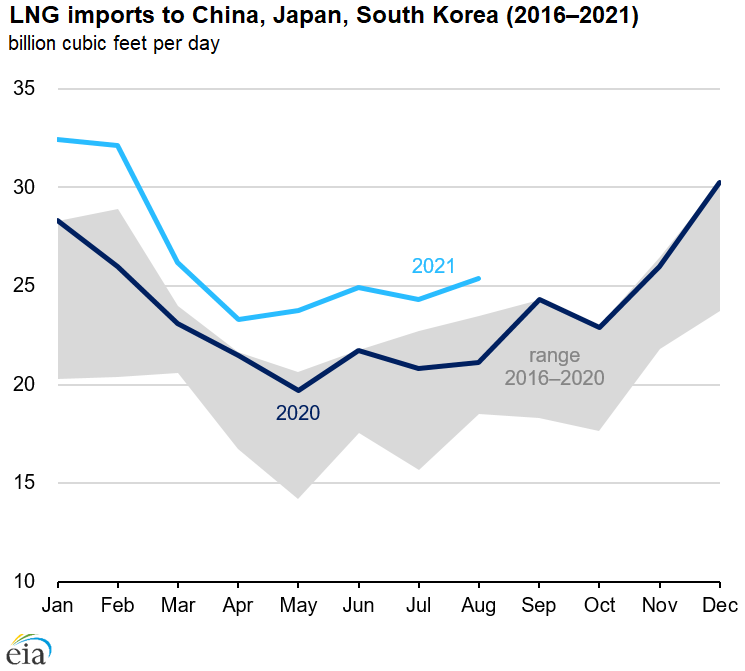 Source: Graph created by the U.S. Energy Information Administration, based on data from Japan Ministry of Finance, South Korea International Trade Association, China General Administration of Customs
Source: Graph created by the U.S. Energy Information Administration, based on data from Japan Ministry of Finance, South Korea International Trade Association, China General Administration of Customs
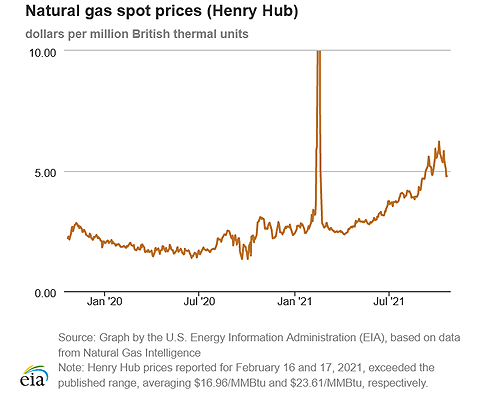
| Spot Prices ($/MMBtu) | Thu, 14-Oct |
Fri, 15-Oct |
Mon, 18-Oct |
Tue, 19-Oct |
Wed, 20-Oct |
|---|---|---|---|---|---|
| Henry Hub |
5.83 |
5.46 |
5.08 |
4.78 |
4.79 |
| New York |
5.24 |
4.60 |
4.49 |
3.96 |
4.15 |
| Chicago |
5.62 |
5.00 |
4.81 |
4.63 |
4.83 |
| Cal. Comp. Avg.* |
6.12 |
5.90 |
5.97 |
5.60 |
5.72 |
| Futures ($/MMBtu) | |||||
| November contract | 5.687 |
5.410 |
4.989 |
5.088 |
5.170 |
| December contract |
5.837 |
5.600 |
5.236 |
5.350 |
5.447 |
| *Avg. of NGI's reported prices for: Malin, PG&E Citygate, and Southern California Border Avg. | |||||
| Source: NGI's Daily Gas Price Index | |||||
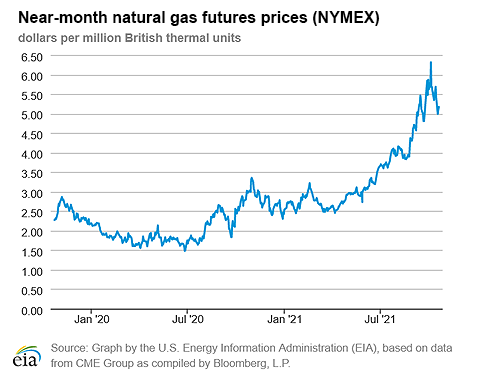
| U.S. natural gas supply - Gas Week: (10/14/21 - 10/20/21) | |||
|---|---|---|---|
Average daily values (billion cubic feet) |
|||
this week |
last week |
last year |
|
| Marketed production | 103.7 |
104.3 |
100.7 |
| Dry production | 92.2 |
92.8 |
89.6 |
| Net Canada imports | 5.8 |
5.0 |
3.4 |
| LNG pipeline deliveries | 0.1 |
0.1 |
0.1 |
| Total supply | 98.1 |
97.8 |
93.0 |
|
Source: Chart by the U.S. Energy Information Administration (EIA), based on data from IHS Markit | |||
| U.S. natural gas consumption - Gas Week: (10/14/21 - 10/20/21) | |||
|---|---|---|---|
Average daily values (billion cubic feet) |
|||
this week |
last week |
last year |
|
| U.S. consumption | 63.4 |
62.3 |
67.2 |
| Power | 27.7 |
30.9 |
30.7 |
| Industrial | 21.7 |
21.2 |
22.1 |
| Residential/commercial | 14.0 |
10.2 |
14.4 |
| Mexico exports | 5.9 |
5.7 |
6.1 |
| Pipeline fuel use/losses | 6.2 |
6.2 |
6.1 |
| LNG pipeline receipts | 10.9 |
10.5 |
7.6 |
| Total demand | 86.3 |
84.7 |
87.0 |
|
Source: Chart by the U.S. Energy Information Administration (EIA), based on data from IHS Markit | |||
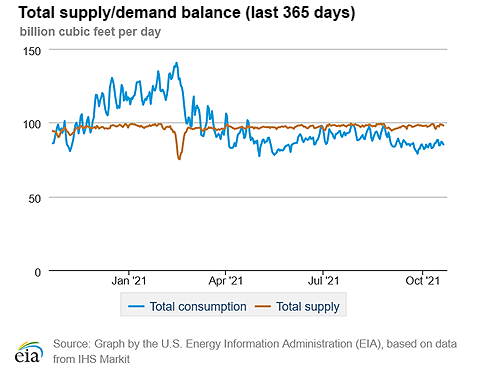
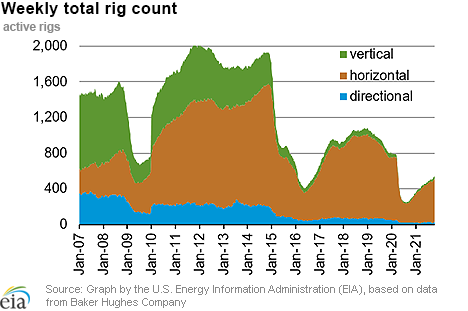
| Rigs | |||
|---|---|---|---|
Tue, October 12, 2021 |
Change from |
||
last week |
last year |
||
| Oil rigs | 445 |
2.8% |
117.1% |
| Natural gas rigs | 98 |
-1.0% |
32.4% |
| Note: Excludes any miscellaneous rigs | |||
| Rig numbers by type | |||
|---|---|---|---|
Tue, October 12, 2021 |
Change from |
||
last week |
last year |
||
| Vertical | 30 |
7.1% |
42.9% |
| Horizontal | 481 |
-0.4% |
100.4% |
| Directional | 32 |
45.5% |
52.4% |
| Source: Chart by the U.S. Energy Information Administration (EIA), based on data from Baker Hughes Company | |||
| Working gas in underground storage | ||||
|---|---|---|---|---|
Stocks billion cubic feet (Bcf) |
||||
| Region | 2021-10-15 |
2021-10-08 |
change |
|
| East | 862 |
834 |
28 |
|
| Midwest | 1,027 |
997 |
30 |
|
| Mountain | 211 |
210 |
1 |
|
| Pacific | 253 |
251 |
2 |
|
| South Central | 1,108 |
1,079 |
29 |
|
| Total | 3,461 |
3,369 |
92 |
|
|
Source: U.S. Energy Information Administration Form EIA-912, Weekly Underground Natural Gas Storage Report | ||||
| Working gas in underground storage | |||||
|---|---|---|---|---|---|
Historical comparisons |
|||||
Year ago (10/15/20) |
5-year average (2016-2020) |
||||
| Region | Stocks (Bcf) |
% change |
Stocks (Bcf) |
% change |
|
| East | 921 |
-6.4 |
892 |
-3.4 |
|
| Midwest | 1,102 |
-6.8 |
1,047 |
-1.9 |
|
| Mountain | 244 |
-13.5 |
219 |
-3.7 |
|
| Pacific | 323 |
-21.7 |
305 |
-17.0 |
|
| South Central | 1,329 |
-16.6 |
1,148 |
-3.5 |
|
| Total | 3,919 |
-11.7 |
3,612 |
-4.2 |
|
| Source: U.S. Energy Information Administration Form EIA-912, Weekly Underground Natural Gas Storage Report | |||||
| Temperature – heating & cooling degree days (week ending Oct 14) | ||||||||
|---|---|---|---|---|---|---|---|---|
HDDs |
CDDs |
|||||||
| Region | Current total |
Deviation from normal |
Deviation from last year |
Current total |
Deviation from normal |
Deviation from last year |
||
| New England | 29 |
-61 |
-40 |
0 |
0 |
0 |
||
| Middle Atlantic | 12 |
-67 |
-42 |
3 |
1 |
3 |
||
| E N Central | 10 |
-73 |
-32 |
23 |
21 |
22 |
||
| W N Central | 35 |
-45 |
-4 |
11 |
8 |
0 |
||
| South Atlantic | 2 |
-39 |
-11 |
47 |
16 |
-2 |
||
| E S Central | 2 |
-38 |
-9 |
48 |
33 |
23 |
||
| W S Central | 2 |
-11 |
0 |
72 |
36 |
8 |
||
| Mountain | 104 |
26 |
66 |
5 |
-10 |
-20 |
||
| Pacific | 64 |
36 |
53 |
0 |
-11 |
-15 |
||
| United States | 27 |
-32 |
-3 |
25 |
11 |
2 |
||
|
Source: Chart by the U.S. Energy Information Administration (EIA), based on data from the National Oceanic and Atmospheric Administration Note: HDDs=heating degree days; CDDs=cooling degree days | ||||||||
Average temperature (°F)
7-day mean ending Oct 14, 2021
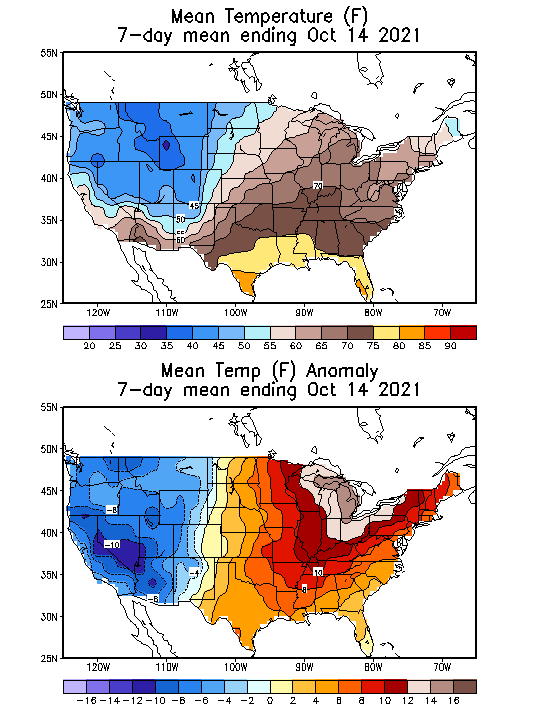
Source: National Oceanic and Atmospheric Administration
Deviation between average and normal (°F)
7-day mean ending Oct 14, 2021

Source: National Oceanic and Atmospheric Administration

